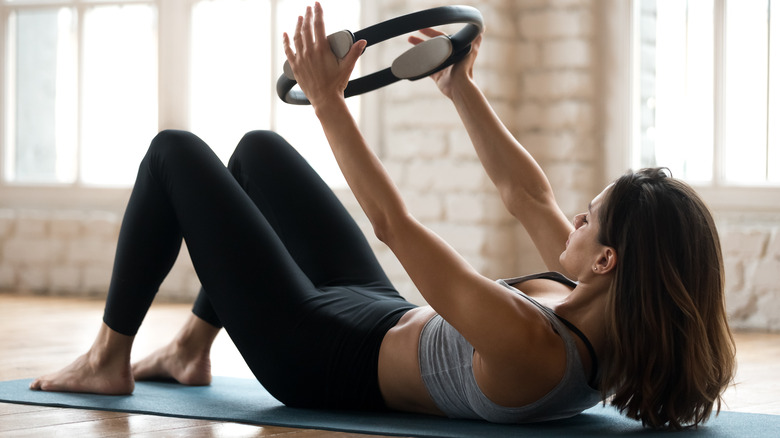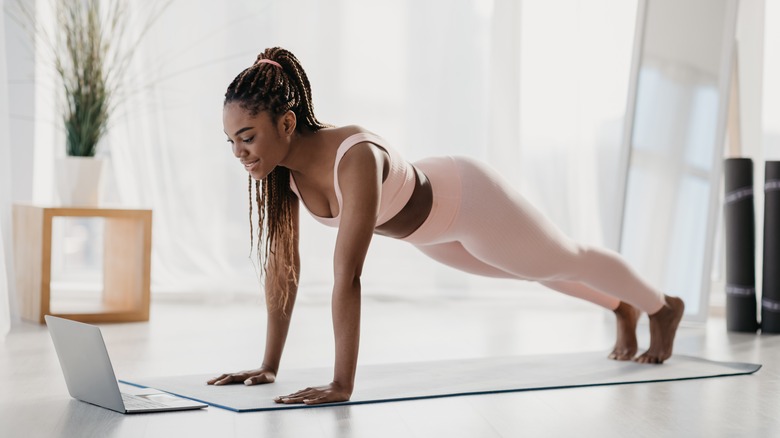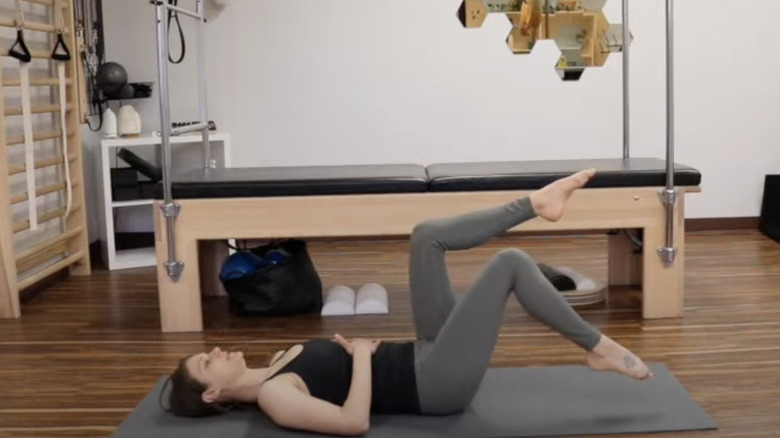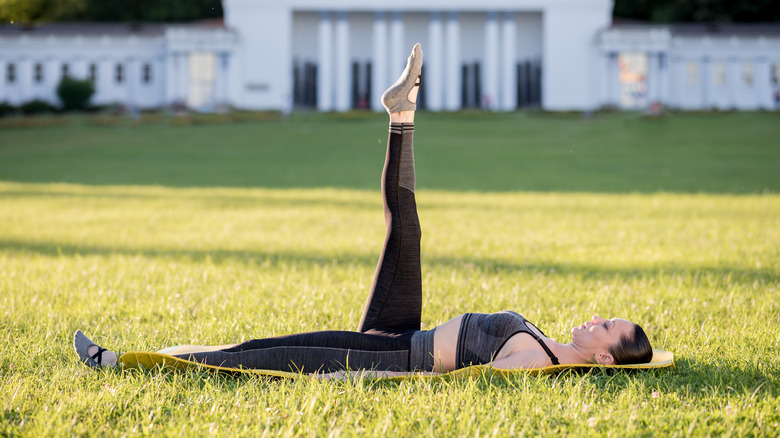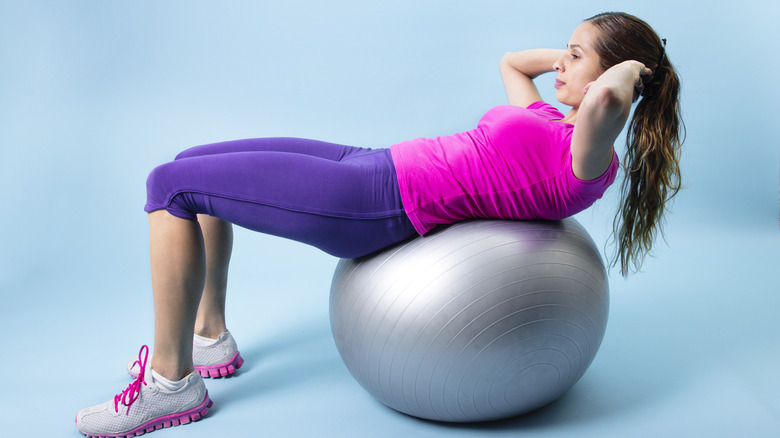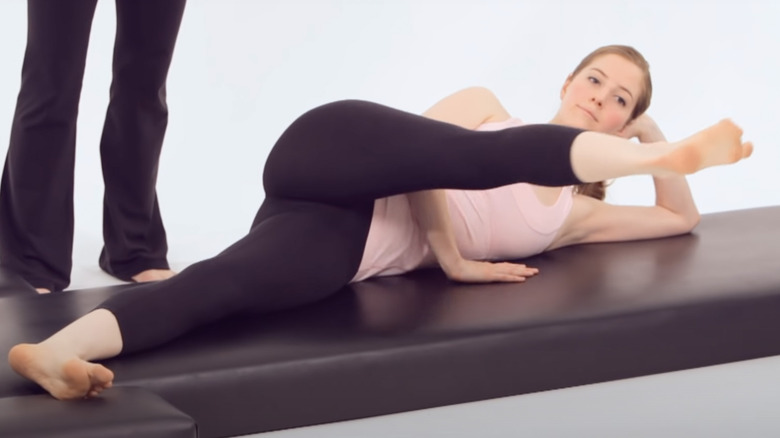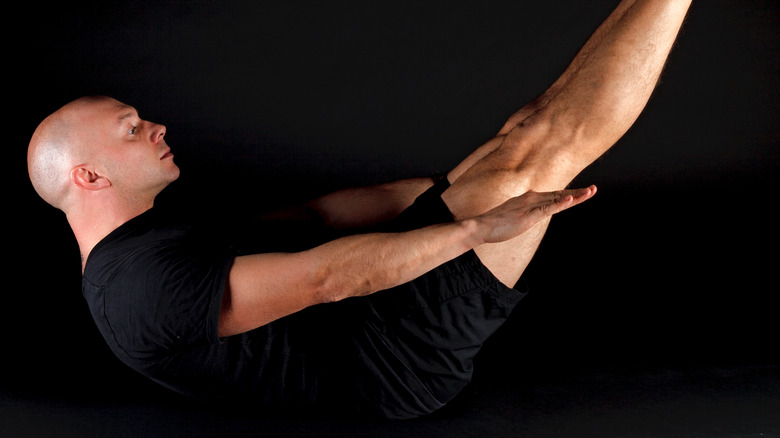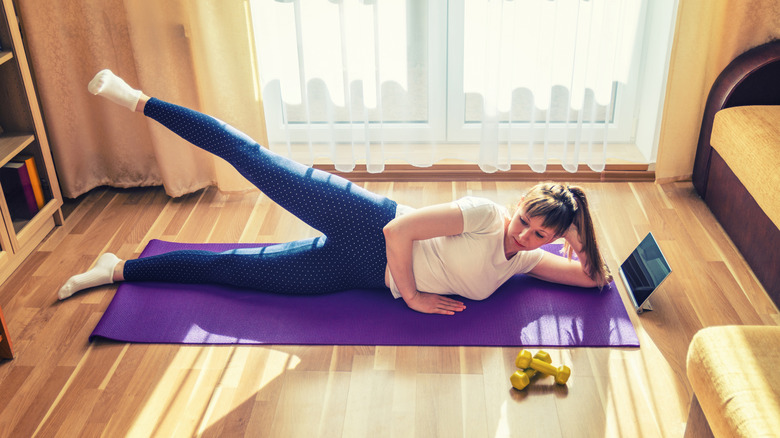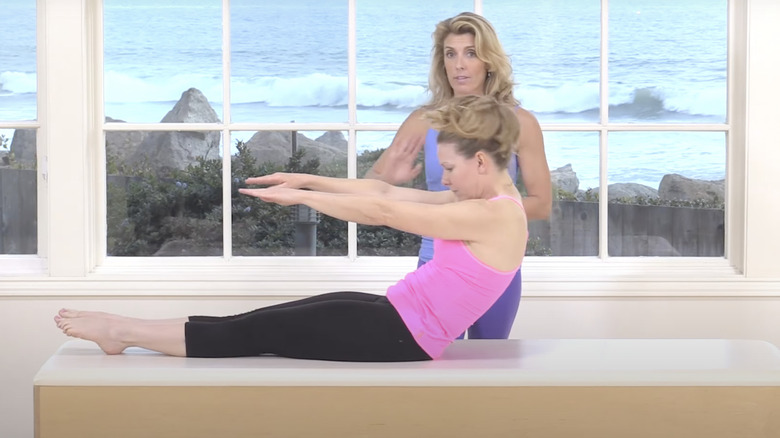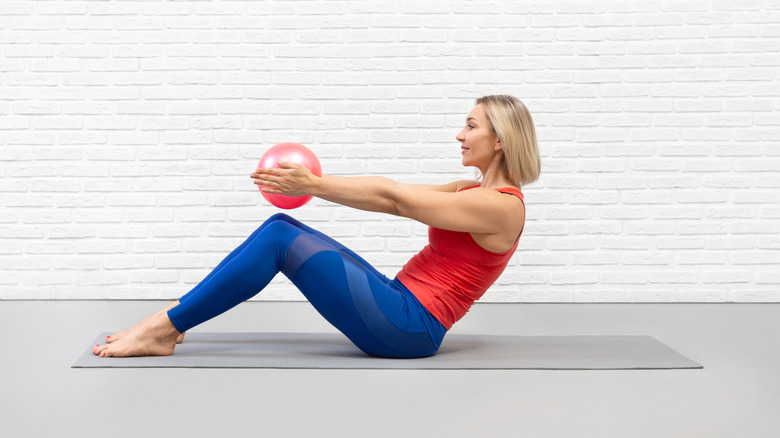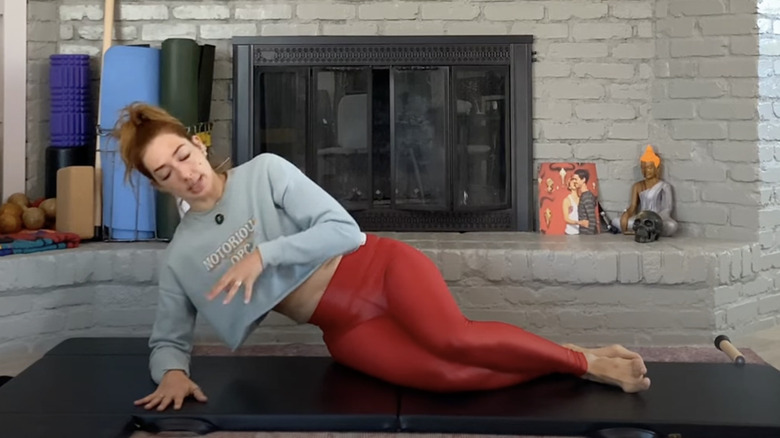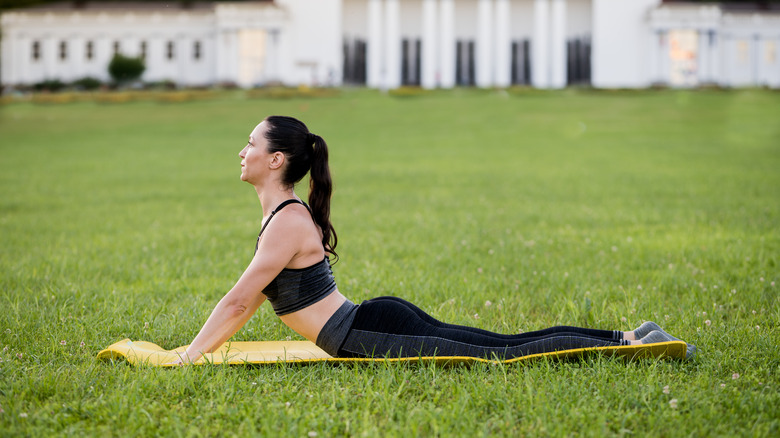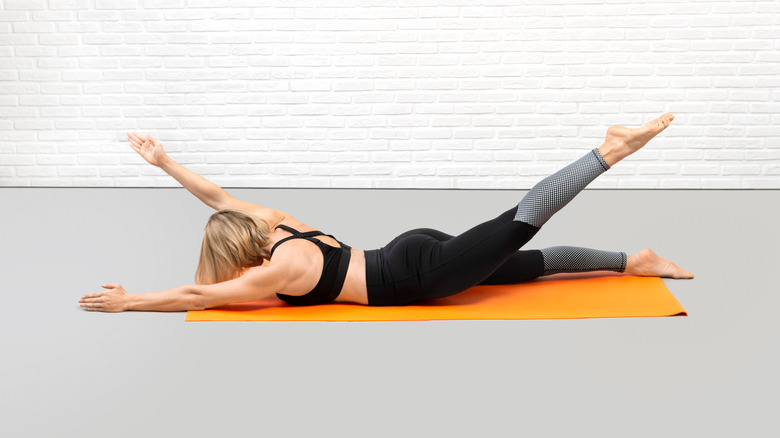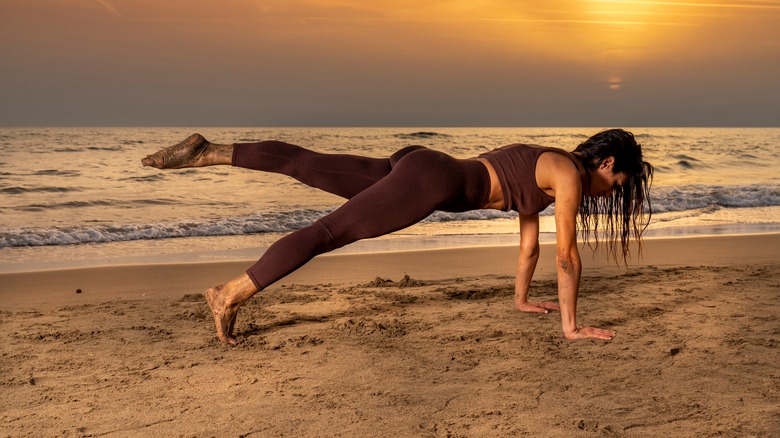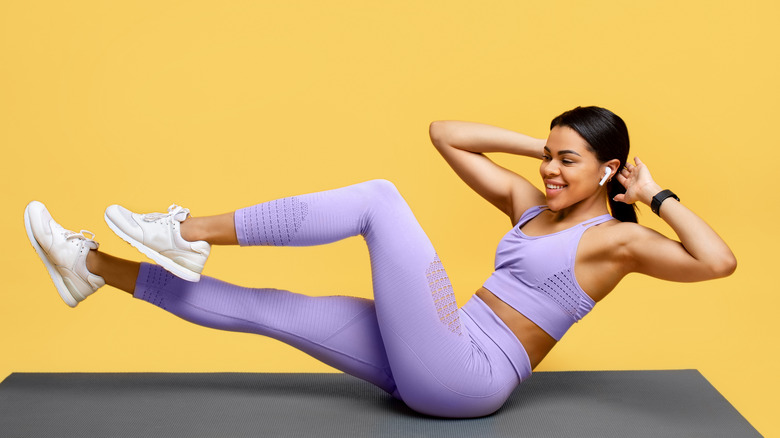The Best Pilates Moves To Strengthen Your Core
Pilates is a whole mood, you guys. There was a time when Pilates flew somewhat under the radar as a way to work out, but nowadays, more and more people are discovering the benefits of getting on the mat. Like Yoga, Pilates is an easily-accessible way to build muscle tone, improve flexibility and posture, and get your heart rate up (per Women's Health Magazine).
Given that one of the critical aspects of Pilates is an emphasis on working from your body's center, involving the hip, glutes, and core muscles (also known as the Powerhouse, according to Power Pilates), you can rightly expect the exercise style to deliver benefits to your stomach. "Pilates is a mind-body workout that targets your core muscles with every exercise," confirms Club Pilates instructor Manuela Sanchez via SELF, who points out that many Pilates moves focus not only on the outer abdominals but your deep core muscles too, providing a rock-solid center.
But as with any workout, certain moves will be less useful for specific muscles — and others will be the ones you'll really want in your repertoire. That's why we put together our list of the top Pilates moves for your core.
Plank rock
The plank is pretty much part of the gospel when it comes to exercise enthusiasts, and we can see why. A cornerstone of many Pilates practices, planks are an easy-to-adjust staple move that works your core efficiently, as well as activating other muscles throughout your body, and provides benefits for balance and flexibility, explains Healthline.
And one of the best things about planks is that small changes to the standard move can activate your muscles in huge ways. This is the case with the plank rock, a Pilates move that introduces light motion to keep your muscles moving and working. Begin by moving into a high plank, with your arms fully extended (but not locked) under you, and a straight line running from your heels to your head, explains SELF. Gently rock your weight forward, so that your body shifts forward several inches, and then repeat the rocking motion back, so that your weight's just behind your arms. Continue the motion back and forth for as long as you're able to, ensuring that your core muscles, as well as your upper legs and glutes, stay activated. Rest, and then repeat.
Toe taps
If you've ever taken a Pilates class, you'll know that you spend a lot of time on your back. And these back-based moves, many of which are fundamental to Pilates practice, can look pretty simple on the surface but can provide a killer core workout. One of these moves is the toe tap, which utilizes a gentle leg movement to torch both your rectus and traverse abdominis, according to Healthline.
Grab an exercise mat, and lie on your back, placing your arms on either side of your body to stabilize yourself. Bend your knees, and then bring them up to your body, so that your thighs are at a 90-degree angle to the floor. Ensure that your lower back doesn't arch while you do so. Then, gently lower one of your legs and tap your foot on the floor, keeping your other leg raised, and engaging your core while you do so. Bring your lowered leg back up to the raised position, and then repeat the movement with the other leg. Alternate tapping your feet 10 times on each side, for a complete set, and then rest.
You can also do this move by tapping both feet at the same time, to make it even more challenging for your core.
Leg circles
Of all the Pilates moves out there for your core, leg circles are probably the most deceptive. "Leg circles look easy, but they are incredibly difficult to do properly," states certified strength and conditioning specialist Erica Suter via Beach Body On Demand. By simply using one leg, you're activating a huge number of body parts, with the abs being worked effectively. Additionally, "Leg circles crush the glutes, especially the hip abductors," Suter says, as well as your hip flexors.
To do this move, you'll need a mat and enough floor space to lie down. Position yourself on your back, with your legs extended out and flat on the floor. Put your hands beside you, palm-down on the floor, to stop your body from moving too much during the move. Activate your core (which will keep your back flat) and slowly raise one of your legs, keeping it straight, until it's pointing directly at the ceiling. Then, start to move your foot in fairly large circles, moving clockwise for as many reps as you desire, before repeating the motion in the other direction. Return your leg to the floor, and then do the same with the other leg. If it's too challenging to create large circles, you can make them smaller.
Pilates core crunch
There's no denying that the crunch is one of the most effective moves for your core, and the Pilates core crunch takes it to the next level. By incorporating a yoga ball and some additional leg movement, this is a move that challenges stability while also generating a wider range of motion through your abdominal muscles.
Grab your yoga ball and mat. Sit on the ball, with legs bent and feet flat on the floor. Slowly walk your feet until the ball is behind your (middle) back, above your lumbar spine, and then put your hands behind your head. Once you're balanced, "Exhale and lift your upper body by about 45 degrees, pulling the deep abs in toward the spine, and inhale to return to lower to the starting position" (via PopSugar). Ideally, you should aim to do 10 reps with each leg, before repeating with the other leg. The key here is to try and keep your pelvis as still as possible: If it starts to rock, you may need to engage your core even more.
Side kick
There's often a lot of focus on working your abs while on your back, but moves that work on your side not only offer a welcome break from crunches and sit-ups but give you a new plane of movement to work. The side kick is a Pilates move that does just that, lying on your side to work your core, hips, thighs, and back extensors, as Pilates Anytime states.
Lay your mat on the floor, and lie down on one side, ensuring that your body's straight from your feet to the top of your head. Place one hand under your head and prop yourself up on your elbow, placing your other hand in front of you on the mat, to stabilize your body. Gradually shift your legs forward slightly, so that they're at an angle to your body, and then, slightly raise the top leg, and kick it forward, keeping it straight. Return the leg to the original position, without relaxing it so it doesn't drop down, and repeat the kick. You should feel the activation through your core as you do so. Make sure, when moving your leg back, you're not going too far, as you don't want to crunch your lower back.
The hundred
No Pilates workout would be complete without the hundred making an appearance somewhere. The hundred is a core move that "helps to strengthen and sculpt the abs because it helps engage the transverse abdominals, which basically means the deepest set of muscles you have in your lower belly," explains Pilates instructor Kit Rich via SELF. Not only that, but the hundred is a great example of a move that incorporates all of the principles of Pilates, including centering, concentration, breathing, and flow, while giving you a great workout, Rich says.
As so often in Pilates, you'll be doing this move on your back, so grab your mat and lie on the floor. Keep your legs bent, and then shift them up, so that your thighs are around 65 degrees from the floor. From here, extend your lower legs, bringing your chest and head up to activate your core, and keep your arms straight beside you, palms down. Now, once you're in this position, engage your triceps, and pump your arms up and down. For every 10 pumps, you'll need to inhale five times and exhale five times. Try and repeat the motion for a total of 100 pumps (hence the name!) and then rest.
Side leg lift
We mustn't forget about our obliques, folks. Running down the sides of our bodies, our obliques round out our core, and also keep our postures healthy, which thereby helps to prevent injuries and back pain (per Pilates Fitness). But we can't solely rely on front-focused ab exercises to work our obliques, and that's why the side leg lift is so important, which hits our core from the side to deliver a killer workout.
Begin by lying on your side, with your body straight, explains the Perfect Balance Clinic. Keep your arms relaxed, and placed in front of you to keep your body stabilized. Breathe in, lift your top leg, and then start to draw circles with it, moving in a forward motion at first. Aim to do around six circles, before repeating the circles in the other direction. Don't go slack through your core as you do this, as it needs to remain constantly engaged. Then, flip over to the other side, and repeat with the other leg. If you want to kick it up a notch, place your top arm on the outside of your upper leg, which provides an additional challenge as you lose the stability it gives you.
The roll-up
Roll-ups are everywhere you look in Pilates classes — and no, we're not talking about the snack here. This move is likely one of the first you'll learn in a Pilates setting, and there's good reason for that. Not only does it embody the core principles of Pilates in a single move, but it also activates your core even more effectively than a regular sit-up, according to Complete Pilates.
The key to the roll-up, though, is not to underestimate it: While seemingly simple, this move requires correct form. Begin by lying on your mat, face-up, with your legs extended and your arms extended out above your head, flat on the floor. Take a breath in, and as you breathe out, bring your arms up in a curve, over your head. Once they're directly above your head, bring the top of your upper body off the mat. Breathe in, and while breathing out, continue to move your upper body, rolling up until your body is completely curved, and your arms are extended in front of you. Your spine should be in a "C" shape, with your arms over your legs. On an out breath, roll your spine back out, so you're lying in the original position.
Half roll back
We're so used to ab exercises that move our body inward on itself, that we forget there is a range of core moves that work through extending the body. This is the case with the half roll back, a core exercise that works your lower abs specifically, while also tending to your spine, as Get Healthy U explains. Your upper abs come along for the ride, too, making this a total core move that you'll be feeling after your workout.
You'll start in a seated position on your mat, with your knees bent and your heels resting on the ground. Place your arms in front of you, in a hoop shape, or hold a ball in front of your chest. Make sure that your back is straight. From here, contract your abs to activate them, and then gently start to lower your upper body down onto the mat, vertebrae by vertebrae, until your middle back comes into contact with the mat. Once here, try (if possible) to activate your core even more, as you roll your body back up until you're in your original position. This move takes control, so take it slow. Repeat as many times as you desire, and then rest.
Side bend preparation
Okay, so we'll be the first to admit that the side bend preparation doesn't have the snappiest name in the book, but believe us when we say that it's great for your core. This move is great for your obliques specifically, as Healthline states, as well as your shoulder girdle stabilizers, vital for keeping your upper body movements strong and stable (per Physiopedia).
This move can take a little practice to get right, but it's worth it. Start by lying on your mat on one side, with your upper arm stacked under your shoulder, and your knees bent. If you wish, you can raise your other arm into the air, or rest it on your hip. Then, elevate your hips by pushing into the arm on the floor, breathing out as you do so. Hold the position at the top briefly, and then inhale while allowing your hips to lower around halfway. Lift your hips again, on an out-breath, and repeat the motion for up to 10 reps. Once you've done that, lower your entire body to the starting position, switch sides, and repeat on the other side.
Swan dive
Because we spend our lives looking forward, it's easy to forget about our backs and backward-moving exercises that can work our muscles. And crucially, these backward-moving workout moves can help us build strength in the front of our bodies. The swan dive does just this, working our abs while simultaneously blasting our hip and back extensors, according to Healthline.
To do this move, lie face down on your mat, and place your hands on either side of you, roughly at shoulder or neck height. Ensure that the tops of your feet are flat on the ground, too. Activate your abs, making sure that you're not sagging through your lower back, and then breathe in, and push your hands into the floor. As you do so, your upper body should lift away from the mat, with your chest and ribs peeling up. Lift until you've reached your maximum range of motion, hold the position, and then exhale to allow your body to come back to the mat. If this is too large of a motion for you to do, you can just raise it slightly, keeping your abs in contact with the mat.
Pilates swimming
Who says that you need a swimming pool to go swimming? We certainly don't think so — and Pilates instructors don't either, if the Pilates swimming exercise is anything to go by. Pilates swimming utilizes the movement of a front crawl in the pool and places it firmly on dry ground, and in doing so works your core and deep abdominal muscles and back — it also improves your posture and mobility (per Spotebi).
Begin by grabbing your mat, rolling it out, and then lying face-down on it. Your arms should be extended out from you in front of your head, and your back legs should be fully straight, too. Then, in one move, lift your back legs and upper body off the floor simultaneously. Start to move your arms and legs in a swimming motion, raising and lowering them on opposing sides, for a maximum of 16 reps, before resting and repeating. This move can be a little destabilizing, so take it slow in the beginning, and then once you've figured it out, you can speed it up.
Leg pull front
One of the things we absolutely love about Pilates is how it can take simple movements and create huge results out of them. The leg pull front is a great example of this. Taking a regular full plank and adding a subtle leg movement produces results throughout your body, from the core being worked effectively to activation and strength-building in your upper arms and pelvis, explains Pilates Union.
Begin on your mat on all fours, with your limbs placed directly underneath your joints. Then, on an exhale, move into a full plank, straightening first one leg, then the other, until your body's in a straight line. From here, the movement is simple but controlled. Inhale, and then on an exhale, contract your abdominal muscles, and gently bring one foot off the ground, bending the toe if you wish, and holding it away from the mat briefly. Return it to the floor, and then repeat with the other leg. As you do this, you'll want to make sure that your body isn't tipping or bending backward, as this will reduce the activation through your core. Ensure that your hips and pelvis aren't curving, too, keeping them level with the ground.
Criss cross
Similar to a bicycle crunch, the criss cross is a move that your core will love you for (even if you'll be feeling the burn long afterward). With the lifting and twisting action that the criss cross provides, you achieve an activation both through your central abdominals and obliques, as Complete Pilates explains. Additionally, you'll generate strength in your hip flexors, and encourage movement through your spine, keeping it flexible.
Lie flat on your back, with your legs outstretched and your arms gently behind your head. Bend your legs, and bring them up, so that your knees are at a 90-degree angle. Ensure that your elbows are wide, and then breathe out, extending one leg away from you as you do so. Simultaneously, you'll want to bring the elbow on the same side inward and toward your bent knee, with a twist occurring through your center. Bring your elbow back to its original position as you bend your straight leg again while breathing in, and then repeat in the other direction on an exhale. Continue doing the motion on each side for up to 45 seconds, before resting, and then repeating for another set.

